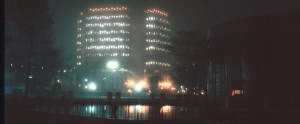
Some questions don’t have immediately apparent answers, but are important because of the expanding array of open-ended questions that result from them. Many who routinely deal with such topics are well-versed in rote knowledge and empirical data – but (perhaps even more importantly) they also act as facilitators for the fluid, polydirectional discussions of these topics.
Presenting for the first time at SXSWi, Dr. Joanna Guldi (Harvard Society of Fellows and Mellon Postdoctoral Fellow in Digital History) is one such facilitator. She, Adam Greenfield (Managing Director of Urbanscale), and Igor Schwarzmann (Managing Director of Third Wave GmbH) will be bringing their engrossing discussion of the future to SXSWi 2011 under the heading “How Does SciFi Influence Our Future Cities?”
Heavy stuff, no doubt. In a recent interview with Dr. Guldi, she provided additional insight into trends affecting the urban environments of the future. With quotes too good to be subjected to journalistic butchery, here are her responses to a few of the questions presented:
Q: Does your personal view of future cities tend to be more utopian or more apocalyptic?
A: “The way we’re headed in North America doesn’t look that much different from the last two hundred years. In Kansas City and San Francisco and Chicago and St. Louis, affluent whites are moving from the suburbs to the center of the city, remembering that it’s nice to walk to work, channel time to meditation, and know one’s neighbors. Unfortunately, they’re also displacing poor ethnic populations to the edge of town, where the housing stock is less able to provide for many-person living arrangements, the sewers are out-of-date, and no public transportation exists to bring those folks to work. The result is liable to be the same chronic divides of race and class that plagued the nineteenth and twentieth centuries — only worse, thanks to neoliberalism. Imagine the consequences of no roads or schools in the vast wastelands of predominantly-minority Gary and Cleveland — we’re forming ghettos on the size of entire regions. Those folks will migrate, like the survivors of Hurricane Katrina, to Chicago and Houston, where they will form enormous enclaves still underserved by infrastructure, schooling, the internet, and other public services. It’s a tragedy for the masses, but it doesn’t look that different from the greater sweep of the last two hundred years.

“The real story — which for the moment is pretty dystopian — is staged in the global south. As Mike Davis explains in his Planet of Slums (2006), some several thousand new cities without sewers, water, or roads have materialized over the last two decades of World Bank policy. Those cities could well turn into slave-societies, hovering as they do on the brink of starvation and drought.
“There are exceptions to these stories in the model of Buenos Aires, a city that’s banded together around re-imagining entrepreneurship and participatory democracy. It’s also possible that the land reform movements in countries like Brazil will succeed in bringing about a renegotiation of power that would totally reopen the question of who gets to participate in the design of city and the countryside — the crucial moment upon which all utopian imaginaries are built.”
Q: In reference to your topic, can past developments be used as a valid basis for predicting of future trends?
A: “Historians can’t predict everything, but we tend to do at least as well as futurologists — sometimes better. Already in 1852, techno-utopians like Michael-Angelo Garvey theorized that the age of roads and rail would bring about the melding of minds and the ‘rise of a universal language.’ Present-day utopians like Ray Kurzweil innovate very little on these fantastic claims — the ‘universal medium of thought,’ the eternal reign of peace that follows — we’ve dreamed of it since steam-power. Are we really moving forward as quickly as they say? Kurzweil’s data comes from the Encyclopedia Britannica — he’s a pretty shoddy historian. From the viewpoint of the historical professional, they might as well be placing a date on the return of Jesus Christ.
“The history of technology makes room for more modest and more definite patterns in the relationship of technology to life. In the nineteenth century, when states began building roads and train-lines to serve domestic traffic, the issue of regional divides started to play an enormous role in political struggles. Should the state use this technology to put poor people in the mountains on equal footing with rich folk in the city? Britain thought so, because Adam Smith had shown that connective technology actually enhances the economic power of the nation as a whole. As a result, Britain invented the first infrastructure state, employing civil engineers to connect rich folk and poor. In the age of the internet, digital divides raise the same questions we faced with roads and rail. Will the state step in to bring broadband to the ranch and the ghetto? Will poor kids get ipads in their schools? History predicts that this problem directly obstructs the wishes of would-be utopians.”
Q: Will the technological conveniences of future cities serve to foster dependence and helplessness of their residents?
A: “Well, not the ones I’d advocate. I’m going to be speaking to some 20th-century utopian thinkers including John Boorman, Karl Schroeder, and Kenicho Yoshida who are in fact terribly concerned that we’re building a seeming techno-utopia of pleasure that has great costs. They point to the ignorance and self-indulgence of a blind elite who profit off of the misery of laborers hidden just on the other side of an invisible border.
“None of that sounds very utopian to me. Perhaps a better model would foster curiosity and agency of individuals about the world around them — even to the end of constantly remaking the utopia.
“I can’t speak for Adam or Igor though — maybe they have some other utopias in mind!”
_______
Finally, a logical, rational discussion of what the future may hold. When you attend this panel, remember to take a deep breath as you settle in. You’ll be getting a truly intriguing glimpse into the future – from some of the topic’s most informed minds.
For more information about the presenters and their current projects, visit:
Jo Guldi at http://www.joguldi.com/
Igor Schwarzmann at http://thirdwaveberlin.com/ and http://www.cognitivecities.com/
Adam Greenfield at http://urbanscale.org/
… and be sure to watch for Dr. Guldi’s forthcoming book: The Road to Rule (Harvard University Press, 2011).
